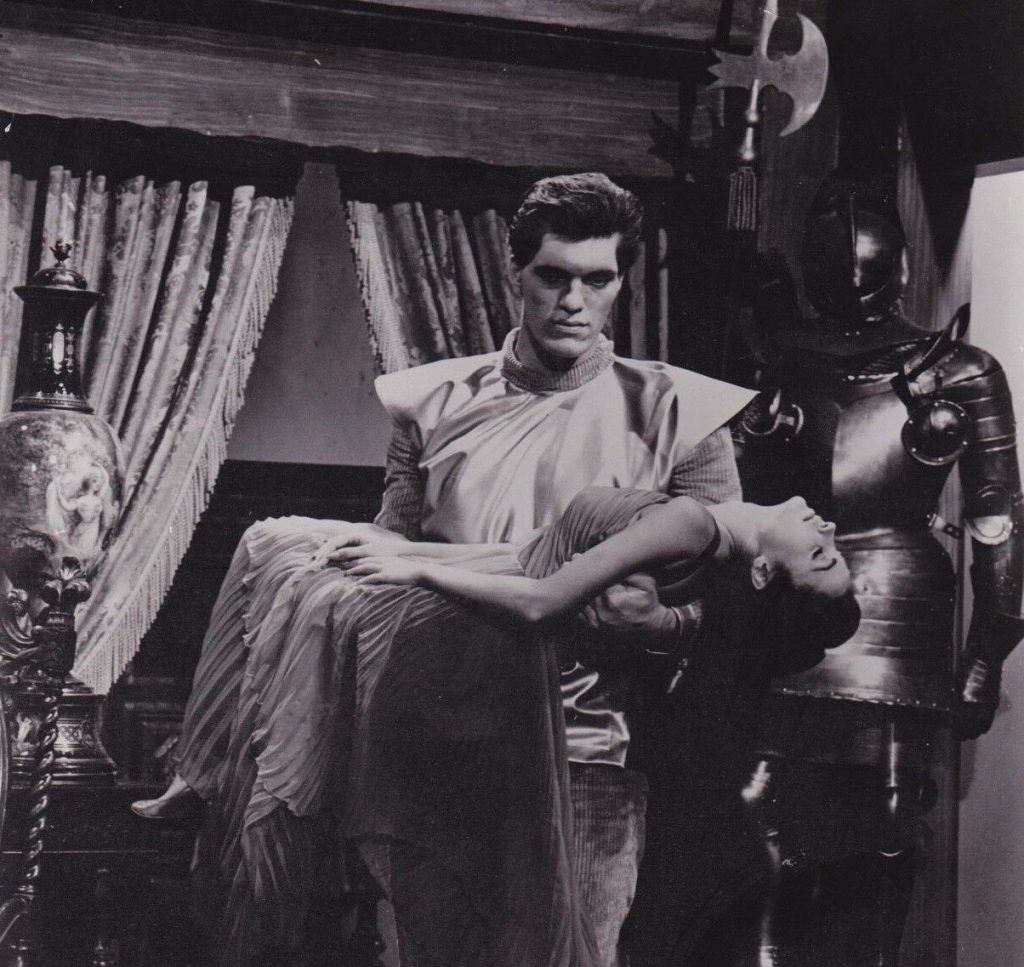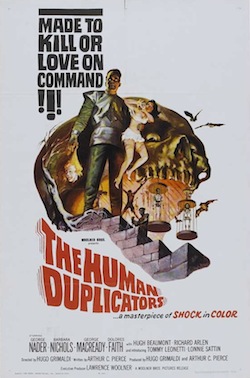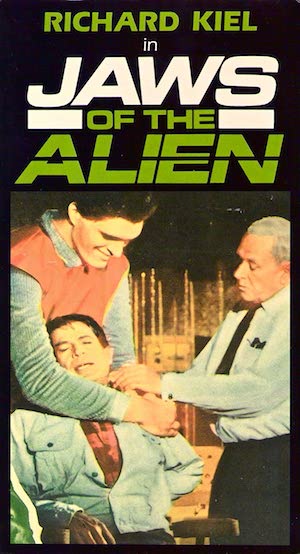
The Human Duplicators (USA-Italy, 1965) 85 min color DIR: Hugo Grimaldi PROD: Hugo Grimaldi, Arthur C. Pierce. EXEC PROD: Lawrence Woolner. SCR: Arthur C. Pierce. MUSIC: Gordon Zahler (from stock). DOP: Monroe P. Askins. MAKE-UP: John Chambers, Bob Mark. SFX: Roger George. CAST: George Nader, Dolores Faith, Richard Kiel, George Macready, Hugh Beaumont, Barbara Nichols, John Indrisano, Ted Durant, Richard Arlen. (Woolner Brothers)

This low-budget US-Italian co-production was first seen by me at 2 o’clock in the morning, syndicated on Elvira’s Movie Macabre. And that seems the perfect time of day to discover an oddball film such as this, that is honourable in its intentions, but muddled due to production deficiencies. Yet, I join those who have a peculiar fondness for it, so much that I’m intrigued to revisit it every few years.
The film’s novelty is in the casting of Richard Kiel (still years away from playing Jaws in the James Bond films). If you remember his turn as the lovesick caveman in Eegah, this picture casts him as a lovesick extra-terrestrial in an interesting spin on the “beauty and the beast” trope, as Dr. Kolos, an alien dispatched to take over the experiments of Professor Dornheimer (George Macready) in his basement lab -which involves making robotic clones of human beings- for his own diabolical purposes. Kolos beams down from his chandelier spaceship, and arrives abruptly in the lab. He informs the doctor that basically he has the right area in his experiments, but must speed up production. As he is saying so, Kolos walks right into the camera lens, so you know he means business.
Most of the action takes place in Dornheimer’s mansion, except for some mysterious low-jinks whenever androids get turned loose to sabotage some stuff. This is enough to incite the curiosity of some standard issue secret agents. Hugh Beaumont (forever known as Ward Cleaver on TV’s Leave it to Beaver) in the guise of Austin Welles sends his trusty agent Glenn Martin (George Nader) to snoop around and see what’s going on. Good old Barbara Nichols hangs around as Gale Wilson, to pour him some hi-balls and discuss the case at hand. Glenn enters the basement laboratory via a conveniently placed cave along the ocean shore, and in a befitting irony, he himself is put to the chair to be duplicated. Just what the movie world needs- two George Naders! Although Nader had a solid career as a second leading man in middleweight Universal pictures, today he is arguably best remembered for, of all things, his appearance in the sci-fi camp classic, Robot Monster. After that, perhaps this science fiction effort is his next durable film in today’s zeitgeist (if perhaps because it was included in the MST3K TV show. But still, there is more to George Nader than that. In the 1960s, he starred as secret agent Jerry Cotton in a string of exciting West German-produced pictures, that are in serious need of revival. When his acting career dried up in the early 1970s, Nader (who had kept his homosexuality a secret during his Hollywood career) authored a science fiction novel, Chrome, which offered a positive look at same-sex relationships!

In hindsight, not much goes on in this picture: every couple of reels, another android goes off to sabotage something. Apparently, this diabolical plot is to have androids wreak havoc to render the human race helpless enough so that Kolos’ super-intelligent race can move in and take over the planet. Lucky for us, the big lug has an Achilles heel– he falls in love with Dr Dornheimer’s blind daughter Lisa (Dolores Faith). This is pulpy stuff, perhaps lifted right from The Fantastic Four comic book, in which The Thing falls in love with blind Alicia, who “sees” the heart beneath his brutish exterior.

If it seems bizarre that such a neat premise for a science fiction movie takes place almost entirely in one mansion, then consider how much screen time in Metropolis was spent in caves. In this Woolner Brothers production, the basement lab and caves are in yellow stucco, the stars out the window of Kolos’ spaceship are like golfballs (and perhaps are), and most bizarre, check out the scene when George Nader explores the caves. There are a couple of caskets that curious George opens. The first reveals an android who didn’t make the cut. The second is a clip of a rising corpse from a European horror movie! (It’s actually a color-tinted clip from the black-and-white film, Castle of Blood, also released stateside by the Woolners.) What this is doing here, I have no idea, but that is part of this film’s infectious charm.
Every few years I put this charming little movie on again, and each time I am delighted, bored, and intrigued. Roger Ebert once said that in the light of everyone remaking old movies, they should only remake the flawed ones. In this case, The Human Duplicators would benefit from a “second try” with proper production values to fully realize its potential. Still, I’d fear that in so doing, they’d replace the personal charm that went into the making of this engaging little movie.
As of this writing, The Human Duplicators has yet to receive a DVD or Blu-ray release (as far as I know). It did make an appearance on VHS, with the alternate title, Jaws of the Alien (cute), to capitalize on Richard Kiel’s post-Bond fame.
